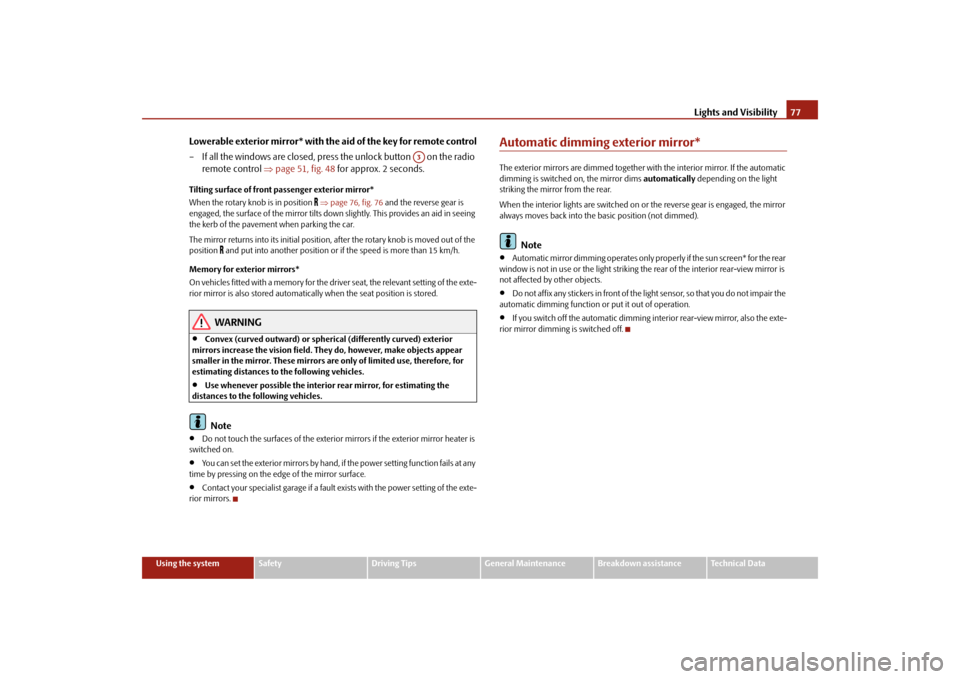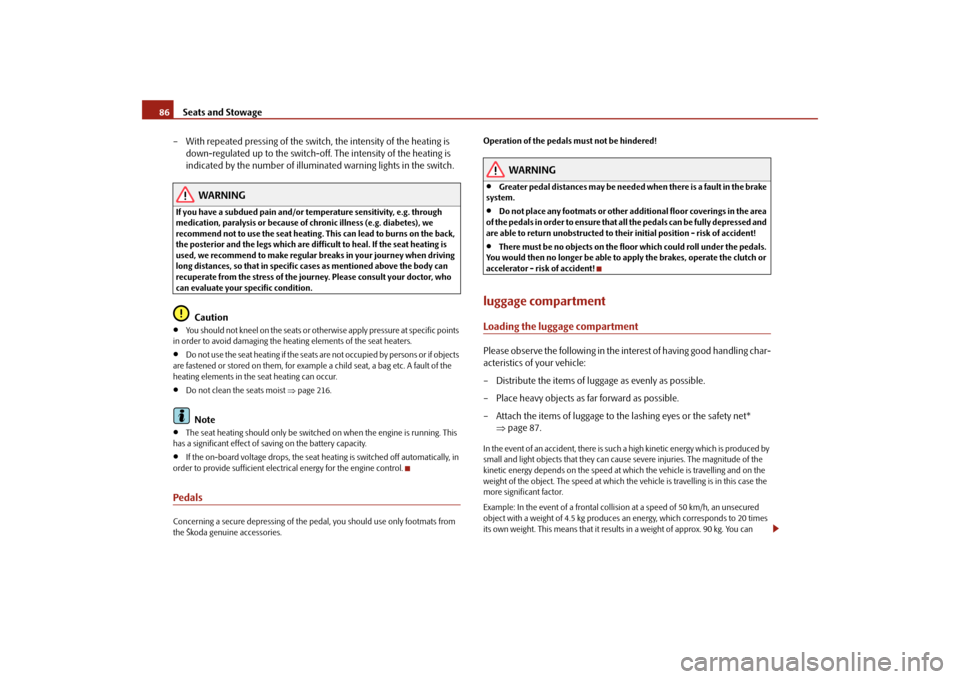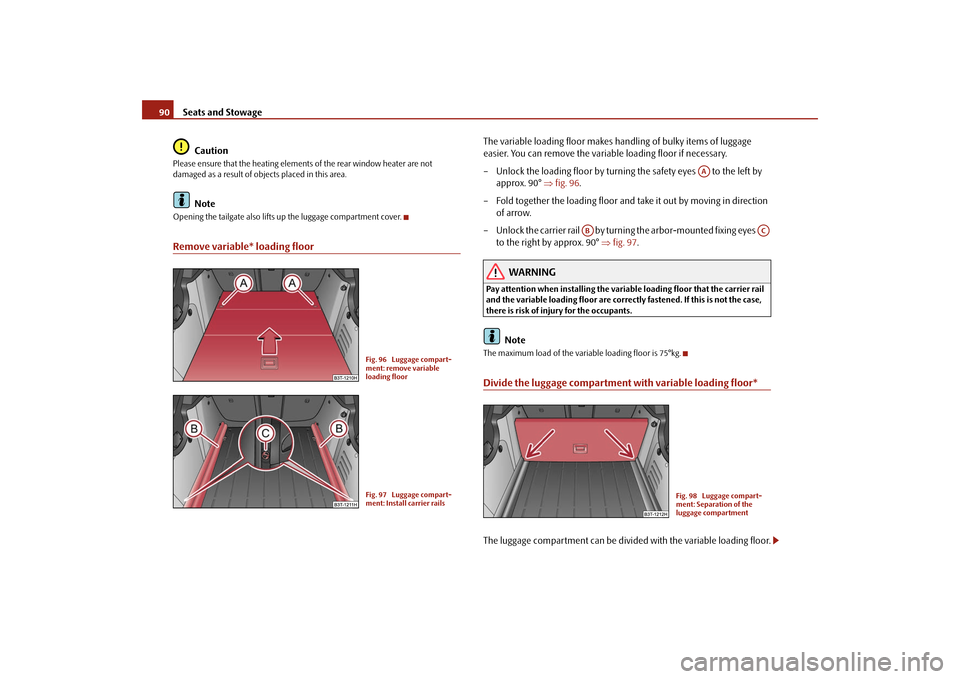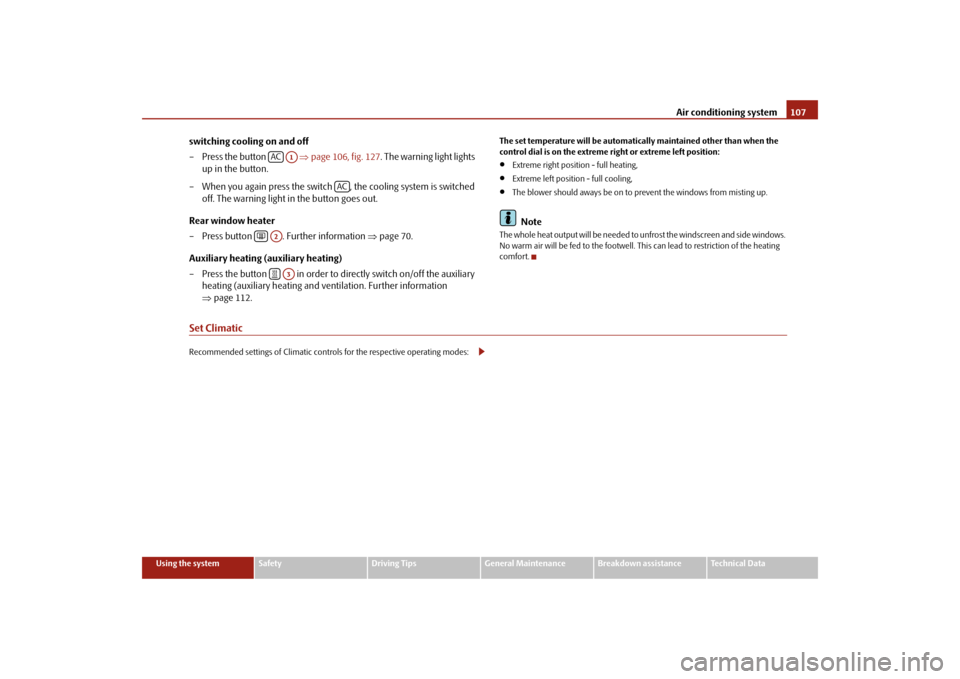heater SKODA SUPERB 2009 2.G / (B6/3T) Owner's Manual
[x] Cancel search | Manufacturer: SKODA, Model Year: 2009, Model line: SUPERB, Model: SKODA SUPERB 2009 2.G / (B6/3T)Pages: 294, PDF Size: 21.33 MB
Page 71 of 294

Lights and Visibility
70
The warning light is located in
the door trim panel below
⇒page 69, fig. 67
.
The warning light goes on every time the door is opened. The light goes out about 10 minutes after opening the door in orde
r to avoid discharging the battery of the
vehicle.Luggage compartment lightThe lighting comes on automatically when the boot lid is opened. The luggage compartment lighting will switch off agai
n automatically if the boot lid remains
open for more than about 30 minutes.Entry lighting*The lighting is positioned on the bottom edge of the exterior mirror. The light beam is directed towards
the entry area of the front door.
The light comes on after the doors have been
locked or on opening the boot lid. The
light goes out after switching on the ignition or up to 30 seconds after closing all the doors, the bonnet and the boot lid. If a door, the bonnet or the boot lid remains open, the light goes out within 2 minutes if the ignition is switched off.
WARNING
If the entry light comes on, do not touch its cover - risk of burns!
VisibilityWindscreen and rear window heaterWindscreen heater* – You can switch the windscreen heater on or off by pressing the switch
⇒
fig. 68
- the indicator light in the switch comes on or goes out.
Fig. 68 Switch for wind- screen heaterFig. 69 Switch for rear window heater
s2dk.1.book Page 70 Wednesday, April 8, 2009 12:23 PM
Page 72 of 294

Lights and Visibility
71
Using the system
Safety
Driving Tips
General Maintenance
Breakdown assistance
Technical Data
Rear window heater – You can switch the rear window heater on or off by pressing the switch
⇒
page 70, fig. 69
- the indicator light in the switch comes on or
goes out.
The windscreen and rear window heater only operates when the engine is running. The windscreen and rear window heater
switches
off automatically after 10
minutes.
For the sake of the environment
As soon as the window is de-iced or free from mist, the heating should be switched off. The reduced current consumption will have a favourable effect on fuel economy
⇒page 205, “Saving electricity”.
Note
•
If the on-board voltage drops, the wi
ndscreen or rear window heater is
switched off automatica
lly, in order to provide sufficient electrical energy for the
engine control.•
The position and the shape of the switch for rear window heater can differ
depending on the equipment installed in the vehicle.
Sun visorsYou can pull the sun visor for the driver or
front passenger out of the fixture and
swivel it toward the door in the direction of the arrow
⇒fig. 70
.
The vanity mirrors in the sun visors are provided with covers. When you slide open the cover in the direction of the arrow , the vanity mirror lighting in the headliner switches on automatically. It switches off again when you slide the cover closed or when you raise the sun visor.
WARNING
The sun visors must not be swivelled to the side windows into the deploy-ment area of the head airbags if any ob
jects, such as ball-point pens etc. are
attached to them. This might result in injuries to the occupants if the head airbag is deployed.
Fig. 70 Sun visor: swivelling outA1
A2
s2dk.1.book Page 71 Wednesday, April 8, 2009 12:23 PM
Page 77 of 294

Lights and Visibility
76
Switching on the automatic dimming – Press the button - the warning light lights up
⇒
page 75, fig. 75
.
Switching off the automatic dimming – Press again the button - the warning light goes out .If the automatic dimming is sw
itched on, the mirror dims
automatically
depending on the light striking the mirror
from the rear. The mirror has no lever on
the bottom edge of the mirror. When the interior lights are switched on or the reverse gear is engaged, the mirror alwa
ys moves back into the basic position.
Note
•
Automatic mirror dimming operates only pr
operly if the sun screen* for the rear
window in the housing on the luggage comp
artment cover is not in use or the light
striking the interior rear-view mirror
is not affected by other objects.
•
Do not affix any stickers in front of the li
ght sensor, so that you do not impair the
automatic dimming function or put it out of operation.•
If you switch off the automatic dimming interior rear-view mirror, also the exte-
rior mirror dimming
is switched off.
Exterior mirror with entry lighting* The lighting is positioned on the bo
ttom edge of the exterior mirror.
The light beam is aimed at the entry area of the front doors after the car is unlocked. The light comes on after the doors have been locked or on opening the front door. The lighting goes out about 30 seconds after
the doors are closed or if the ignition
is switched on. If the doors remain open, the lighting go
es out automatically after about 10 minutes
provided the ignition
is not switched on.
Exterior mirrorYou can adjust the exterior mirrors electrically*.The exterior mirror heater only oper
ates when the engine is running and
up to an outside temperature of +20 °C. Heating of the external mirror – Turn the rotary knob to position
⇒
fig. 76
.
Adjusting left and right exterior mirrors simultaneously – Turn the rotary knob to position
. The movement of the mirror surface
is identical to the movement of the rotary knob.
Adjusting the right-hand exterior mirror – Turn the rotary knob to position
. The movement of the mirror
surface is identical to the movement of the rotary knob.
Switching off operating control – Turn the rotary knob to position
.
Folding in both exterior mirrors* – Turn the rotary knob to position
.
AB
AA
AB
AA
Fig. 76 Inner part of door: Rotary knob
s2dk.1.book Page 76 Wednesday, April 8, 2009 12:23 PM
Page 78 of 294

Lights and Visibility
77
Using the system
Safety
Driving Tips
General Maintenance
Breakdown assistance
Technical Data
Lowerable exterior mirror* with the aid of the key for remote control – If all the windows are closed, press the unlock button on the radio
remote control
⇒
page 51, fig. 48
for approx. 2 seconds.
Tilting surface of front passenger exterior mirror* When the rotary knob is in position
⇒page 76, fig. 76
and the reverse gear is
engaged, the surface of the mirror tilts down slightly. This provides an aid in seeing the kerb of the pavement when parking the car. The mirror returns into its initial position,
after the rotary knob is moved out of the
position
and put into another position or if the speed is more than 15 km/h.
Memory for exterior mirrors* On vehicles fitted with a memory for the driver seat, the relevant setting of the exte- rior mirror is also stored automatica
lly when the seat position is stored.
WARNING
•
Convex (curved outward) or spherical (differently curved) exterior
mirrors increase the vision field. They do, however, make objects appear smaller in the mirror. These mirrors are only of limited use, therefore, for estimating distances to the following vehicles.•
Use whenever possible the interior rear mirror, for estimating the
distances to the following vehicles.
Note
•
Do not touch the surfaces of the exterior mirrors if the exterior mirror heater is
switched on.•
You can set the exterior mirrors by hand, if
the power setting function fails at any
time by pressing on the edge of the mirror surface.•
Contact your specialist garage if a fault exists with the power setting of the exte-
rior mirrors.
Automatic dimming exterior mirror*The exterior mirrors are dimmed together with the interior mirror. If the automatic dimming is switched on, the mirror dims
automatically
depending on the light
striking the mirror from the rear. When the interior lights are switched on or the reverse gear is engaged, the mirror always moves back into the
basic position (not dimmed).
Note
•
Automatic mirror dimming operates only pr
operly if the sun screen* for the rear
window is not in use or the light striking th
e rear of the interior rear-view mirror is
not affected by other objects.•
Do not affix any stickers in front of the li
ght sensor, so that you do not impair the
automatic dimming function or put it out of operation.•
If you switch off the automatic dimming interior rear-view mirror, also the exte-
rior mirror dimming
is switched off.
A3
s2dk.1.book Page 77 Wednesday, April 8, 2009 12:23 PM
Page 86 of 294

Seats and Stowage
85
Using the system
Safety
Driving Tips
General Maintenance
Breakdown assistance
Technical Data
•
Before folding the seat backrest back into the secure position, place the
rear lateral seat belt behind the edge of the side trim panel. Take suitable measures to prevent that
the seat belt is jammed between the seat backrest
and the side trim panel and is thus damaged.Rear seat armrest– You can fold down the armrest to enhance occupant comfort
⇒
fig. 86
.
Seat heaters*You can electrically heat the seat ba
ckrests and the surfaces of the front
seats and the two outer rear seats. – You can switch on and regulate the
seat heating of the driver or front
passenger seat by pressing the surfac
e of the regulator at the point at
which the symbol is located
⇒
fig. 87
.
– You can switch on and adjust the heat
ers of the left or right rear seats
by pressing the regulator
⇒
fig. 88
.
– With one press, you can switch the
heating to highest intensity which
is indicated by the lighting up of the three warning lights in the switch.
WARNING (continued)
Fig. 86 Rear seats: Armrest
Fig. 87 Dash panel: Regu- lator for front seat heatingFig. 88 Centre console at rear: Regulator for heating the rear seats
s2dk.1.book Page 85 Wednesday, April 8, 2009 12:23 PM
Page 87 of 294

Seats and Stowage
86
– With repeated pressing of the switch, the intensity of the heating is
down-regulated up to the switch-off. The intensity of the heating is indicated by the number of illuminated warning lights in the switch.
WARNING
If you have a subdued pain and/or temperature sensitivity, e.g. through medication, paralysis or because of chronic illness (e.g. diabetes), we recommend not to use the seat heating. This can lead to burns on the back, the posterior and the legs which are diff
icult to heal. If the seat heating is
used, we recommend to make regular br
eaks in your journey when driving
long distances, so that in specific cases as mentioned above the body can recuperate from the stress of the journey. Please consult your doctor, who can evaluate your specific condition.
Caution
•
You should not kneel on the seats or otherwise apply pressure at specific points
in order to avoid damaging the heating elements of the seat heaters.•
Do not use the seat heating if the seats are not occupied by persons or if objects
are fastened or stored on them, for exampl
e a child seat, a bag etc. A fault of the
heating elements in the seat heating can occur.•
Do not clean the seats moist
⇒page 216.
Note
•
The seat heating should only be switched
on when the engine is running. This
has a significant effect of sa
ving on the battery capacity.
•
If the on-board voltage drops, the seat
heating is switched off automatically, in
order to provide sufficient electrical energy for the engine control.PedalsConcerning a secure depressi
ng of the pedal, you should use only footmats from
the Škoda genuine
accessories.
Operation of the pedals must not be hindered!
WARNING
•
Greater pedal distances may be needed when there is a fault in the brake
system.•
Do not place any footmats or other additional floor coverings in the area
of the pedals in order to ensure that all the pedals can be fully depressed and are able to return unobstructed to thei
r initial position - risk of accident!
•
There must be no objects on the floor which could roll under the pedals.
You would then no longer be able to
apply the brakes, operate the clutch or
accelerator - risk of accident!luggage compartmentLoading the luggage compartmentPlease observe the following in the inte
rest of having good handling char-
acteristics of
your vehicle:
– Distribute the items of luggage as evenly as possible. – Place heavy objects as far forward as possible.– Attach the items of luggage to the lashing eyes or the safety net*
⇒
page 87.
In the event of an accident, there is such a
high kinetic energy which is produced by
small and light objects that they can caus
e severe injuries. The magnitude of the
kinetic energy depends on the speed at wh
ich the vehicle is travelling and on the
weight of the object. The speed at which the
vehicle is travelling
is in this case the
more significant factor. Example: In the event of a frontal collision at a speed of 50 km/h, an unsecured object with a weight of 4.5 kg produces
an energy, which corresponds to 20 times
its own weight. This means that it results in a weight of approx. 90 kg. You can
s2dk.1.book Page 86 Wednesday, April 8, 2009 12:23 PM
Page 88 of 294

Seats and Stowage
87
Using the system
Safety
Driving Tips
General Maintenance
Breakdown assistance
Technical Data
imagine the injuries that can occur, if this “bullet” is flying through the interior compartment and hits an occupant.
WARNING
•
Store the objects in the luggage comp
artment and attach them to the
lashing eyes.•
Loose objects in the passenger compartment can be thrown forward
during a sudden manoeuvre or in case
of an accident and can injure the
occupants or other oncoming traffic. This risk is still increased, if the objects which are flying around are hit by a depl
oyed airbag. In this case, the objects
which are thrown back can injure the occupants - hazard.•
Please note that the handling properti
es of your vehicle may be affected
when transporting heavy objects as a result of the displacement of the centre of gravity. The speed and style
of driving must be adjusted accord-
ingly.•
The items carried in the luggage compar
tment should be stored in such
a way that no objects are
able to slip forw
ard if there are any sudden driving
or braking manoeuvres undertaken - risk of injury!•
Never drive with the boot lid fully opened or slightly ajar otherwise
exhaust gases may get into the interior of the vehicle - risk of poisoning!•
On no account exceed the permissi
ble axle loads and the permissible
gross weight of the vehi
cle - risk of accident!
•
Never transport occupants in the luggage compartment!Caution
Please ensure that the heating elements of the rear window heater are not damaged as a result of objects sliding in this area.
Note
Tyre pressure must be adjusted to the load
⇒page 235, fig. 210
.
Lashing eyesEyes are located on the sides of the loading area for lashing the goods to be loaded. You can also attach a floor fixing net*
to these eyes for lashing small objects.
WARNING
•
The load to be transported must be fixed in place in such a way that it
cannot move during the journey and when braking.•
If the items of luggage or objects ar
e attached to the lashing eyes with
unsuitable or damaged lashing straps,
injuries can occur in the event of
braking manoeuvres or accidents. In
order to prevent the items of luggage
being thrown forward, always use suit
able lashing straps which are firmly
attached to the lashing eyes.
Fig. 89 Luggage compart- ment: Lashing eyes
s2dk.1.book Page 87 Wednesday, April 8, 2009 12:23 PM
Page 91 of 294

Seats and Stowage
90
Caution
Please ensure that the heating elements of the rear window heater are not damaged as a result of objects placed in this area.
Note
Opening the tailgate also lifts up the luggage compartment cover.Remove variable* loading floor
The variable loading floor makes handling of bulky items of luggage easier. You can remove the variable loading floor if necessary. – Unlock the loading floor by turning the safety eyes to the left by
approx. 90°
⇒
fig. 96
.
– Fold together the loading floor and take it out by moving in direction
of arrow.
– Unlock the carrier rail by turning the arbor-mounted fixing eyes
to the right by approx. 90°
⇒
fig. 97
.
WARNING
Pay attention when installing the variable loading floor that the carrier rail and the variable loading floor are correc
tly fastened. If this is not the case,
there is risk of injury for the occupants.
Note
The maximum load of the variable loading floor is 75°kg.Divide the luggage compartmen
t with variable loading floor*
The luggage compartment can be divided with the variable loading floor.
Fig. 96 Luggage compart- ment: remove variable loading floorFig. 97 Luggage compart-ment: Install carrier rails
AA
AB
AC
Fig. 98 Luggage compart-ment: Separation of the luggage compartment
s2dk.1.book Page 90 Wednesday, April 8, 2009 12:23 PM
Page 108 of 294

Air conditioning system
107
Using the system
Safety
Driving Tips
General Maintenance
Breakdown assistance
Technical Data
switching cooling on and off – Press the button
⇒
page 106, fig. 127
. The warning light lights
up in the button.
– When you again press the switch , the cooling system is switched
off. The warning light in the button goes out.
Rear window heater – Press button . Further information
⇒
page 70.
Auxiliary heating (auxiliary heating) – Press the button in order to directly switch on/off the auxiliary
heating (auxiliary heating and ventilation. Further information ⇒
page 112.
The set temperature will be automatica
lly maintained other than when the
control dial is on the extreme
right or extreme left position:
•
Extreme right position - full heating,
•
Extreme left position - full cooling,
•
The blower should aways be on to prevent the windows from misting up.Note
The whole heat output will be needed to
unfrost the windscreen
and side windows.
No warm air will be fed to the footwell. Th
is can lead to restriction of the heating
comfort.
Set ClimaticRecommended settings of Climatic controls for the respective operating modes:
AC
A1
AC
A2A3
s2dk.1.book Page 107 Wednesday, April 8, 2009 12:23 PM
Page 110 of 294

Air conditioning system
109
Using the system
Safety
Driving Tips
General Maintenance
Breakdown assistance
Technical Data
Climatronic* (automatic air conditioning)Description The Climatronic system is a combin
ation of an automatic heating,
fresh air and cooling system which provides optimal comfort for the occupants of the car.The Climatronic maintains fully automatically a convenience temperature. This is achieved by automatically varying the temperature of the outflowing air, the blower stages and the air distribution. The system also takes into account sunlight which eliminates the need to alte
r the settings manually. The
automatic mode
⇒ page 110 ensures maximum wellbeing of th
e occupants at all times of the year.
Description of Climatronic system The cooling operates only if the following conditions are met:•
engine running,
•
outside temperature above approx. +2°C,
•
switched on.
The AC compressor is switched off at a hi
gh coolant temperature in order to provide
cooling at a high load of the engine. Recommended setting for al
l periods of the year:
•
Set the desired temperature, we recommend 22 °C.
•
Press the button
⇒fig. 128
.
•
Move the air outlet vents
2 and
3 so that the air flow is directed slightly upwards.
Aeration of the vehicle when ignition is switched off* On vehicles fitted with power sliding/tilting roof with solar cells* the fresh air blower is automatically switched over to “solar mode” if the sun rays are sufficient after switching off the ignition. The solar
cells on the sliding/tilting roof deliver
power for the fresh air blower
. This supplies the interior of the car with fresh air.
For an optimum ventilation, the air outlet vents
2 and
3 must be opened
⇒ page 105, fig. 125
.
The ventilation functions only when the sliding/tilting roof is closed.
Note
On vehicles equipped with a
factory-fitted radio* or navi
gation*, the information of
the Climatronic is also shown on the display. This function can be switched off, see operating instructions of the ra
dio* or the navigation system*.
Overview of the control elements The controls enable a separate setting of the temperature for the left and right side.Fig. 128 Climatroni
c: Control elements
The buttons
Defrost windscreen intensively Air flow to the windows Air flow to head Air flow in the footwell Recirculated air mode with air quality sensor Rear window
heater
Buttons / control dial
AC
AUTO
A1
A2
A3
A4
A5
A6
s2dk.1.book Page 109 Wednesday, April 8, 2009 12:23 PM